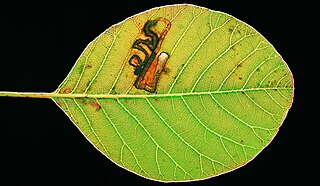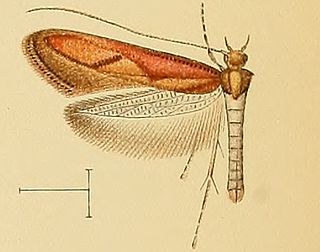
The Anacardiaceae, commonly known as the cashew family or sumac family, are a family of flowering plants, including about 83 genera with about 860 known species. Members of the Anacardiaceae bear fruits that are drupes and in some cases produce urushiol, an irritant. The Anacardiaceae include numerous genera, several of which are economically important, notably cashew, mango, Chinese lacquer tree, yellow mombin, Peruvian pepper, poison ivy, poison oak, sumac, smoke tree, marula and cuachalalate. The genus Pistacia is now included, but was previously placed in its own family, the Pistaciaceae.

Sumac or sumach is any of about 35 species of flowering plants in the genus Rhus and related genera in the cashew family (Anacardiaceae). Sumacs grow in subtropical and temperate regions throughout every continent except Antarctica and South America. Sumac is used as a spice, as a dye, and in medicine.

Pistacia chinensis, the Chinese pistache, is a small to medium-sized tree in the genus Pistacia in the cashew family Anacardiaceae, native to central and western China. This species is planted as a street tree in temperate areas worldwide due to its attractive fruit and autumn foliage.
Amarlu District is in Rudbar County, Gilan province, Iran. Its capital is the city of Jirandeh. Most people of Amarlu District are Tat and they speak Tati.

The comet moth or Madagascan moon moth. is a moth native to the rain forests of Madagascar. The species was first described by Félix Édouard Guérin-Méneville in 1847. The adult moth cannot feed and only lives for 4 to 5 days. Although endangered in the wild due to habitat loss, the comet moth has been bred in captivity.

Ophiusa tirhaca, the green drab, is a moth of the family Erebidae. The species was first described by Pieter Cramer in 1777. It is found in southern Europe, Africa, Australia and the southern parts of Asia.

Akbesia is a monotypic moth genus in the family Sphingidae erected by Walter Rothschild and Karl Jordan in 1903. Its only species, Akbesia davidi, the pistacia hawkmoth, was first described by Charles Oberthür in 1884. It is known from southern Turkey, northern Syria, northern Israel, western Jordan, south-eastern Turkey, north-eastern Iraq, south-eastern Georgia, northern Iran, eastern Afghanistan and Iranian Beluchistan. It may also occur across Azerbaijan, the Alborz Mountains of northern Iran, the Zagros Mountains of western and southern Iran, and northern Afghanistan. It often occurs in large numbers at certain sites in rocky, hilly areas supporting scattered trees and shrubs of Quercus, Olea, Ceratonia and Pistacia.
Teleiopsis terebinthinella is a moth of the family Gelechiidae. It is found in southern and south-eastern Europe, except the Iberian Peninsula and France. It has also been recorded from Turkey and the Near East. It is found up to heights of 1,600 meters (5,200 ft).
Teleiopsis latisacculus is a moth of the family Gelechiidae. It is found in North Macedonia and from Turkey to Egypt.

Pistacia atlantica is a species of pistachio tree known by the English common name Mt. Atlas mastic tree, Atlas pistachio, Atlantic pistacio, Atlantic terebinth, Cyprus turpentine tree, and Persian turpentine tree.

Simplimorpha promissa is a moth of the family Nepticulidae. It is widely distributed in southern Europe with the northern limit running approximately along the southern slopes of the Alps and along the Danube.

Caloptilia betulicola, the red birch slender, is a moth of the family Gracillariidae. It is found from Scandinavia and the north of European Russia to the Pyrenees and Alps and from Ireland to Poland and Slovakia. In the east it is found up to China, Japan and the Russian Far East.

Caloptilia aurantiaca is a moth of the family Gracillariidae. It is known from Madeira and the Canary Islands.
Caloptilia braccatella is a moth of the family Gracillariidae. It is known from Rhodes, Italy, Turkey and the European part of Russia.
Caloptilia flava is a moth of the family Gracillariidae. It is known from southern Russia and Rhodes.

Caloptilia robustella is a moth of the family Gracillariidae. It is known from all of Europe, except the Balkan Peninsula.
Caloptilia belfragella is a moth of the family Gracillariidae. It is known from Quebec and the United States.

Caloptilia rhoifoliella is a moth of the family Gracillariidae. It is known from Bermuda, Canada, and the United States.
Caloptilia ovatiella is a moth of the family Gracillariidae. It is known from California, United States.

Anacardioideae is a subfamily of plants in the family Anacardiaceae.













